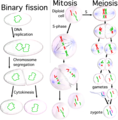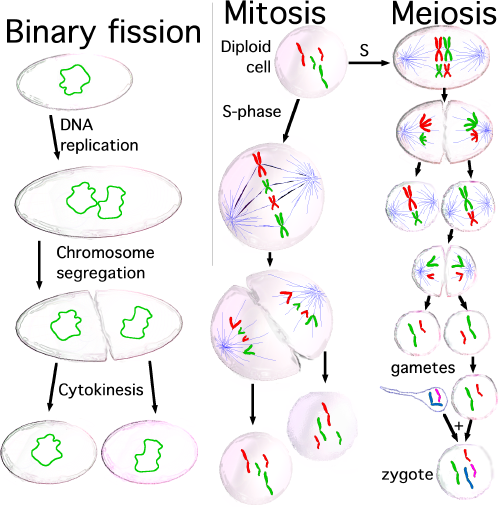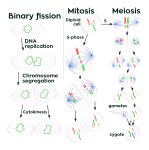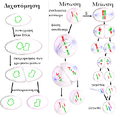
|
このファイルの ベクター画像 (SVG) が利用できます。 使う目的に対し、元画像よりもSVGがより優れている場合、SVG画像を使用して下さい。
|
|
Three types of cell reproduction are compared: the relatively simple Binary fission and two more complicated types that either involve mitosis or meiosis.
Binary fission. Organisms such as bacteria typically have a single chromosome (green). At the start of the binary fission process, the DNA molecule of the cell's chromosome is replicated, producing two copies of the chromosome. A key aspect of bacterial cell reproduction is making sure that each daughter cell gets a copy of the chromosome. Cytokinesis is the actual physical separation of the two new daughter cells.
Cell reproduction that involves mitosis. Most eukaryotic organisms like humans have more than one chromosome. In order to make sure that a copy of each chromosome gets segregated into each daughter cell, the spindle apparatus is used (blue threads). The chromosomes are moved along the long thin microtubules like trains moving along train tracks. Humans are diploid; we have two copies of each type of chromosome, one from the father (red) and one from the mother (green).
Cell reproduction that involves meiosis. The human sex cells (gametes) are produced by meiosis. For sperm production there are two cytokinesis steps that produce a total of four cells, each with half the normal number of chromosomes. The situation is different in the ovaries for egg production where one of the four sets of chromosomes that is segregated is placed in a large egg cell, ready to be combined with the DNA from a sperm cell (see meiosis for details).
This image was created for the cell growth article.
Source: I made this diagram with ClarisDraw and PhotoShop.
Note: a GFDL license for use of this image was automatically granted when I uploaded the image to Wikipedia. Since User:Bevo requested an explicit copyright status statement and since the Wikipedia:Image description page article suggests that "Adding explicit copyright information helps", I am providing one:
- The copyright to this image is retained by John Schmidt (JWSchmidt).
The Wikipedia:Image description page also suggests including an explicit statement about the GFDL license, so:
- Permission is granted to copy, distribute and/or modify this image under the terms of the Wikipedia GFDL, as indicated in the fine print at the bottom of this page. JWSchmidt 15:11, 11 Apr 2004 (UTC)
Source: English Wikipedia, original upload see file history

|
この文書は、フリーソフトウェア財団発行のGNUフリー文書利用許諾書 (GNU Free Documentation License) 1.2またはそれ以降のバージョンの規約に基づき、複製や再配布、改変が許可されます。不可変更部分、表紙、背表紙はありません。このライセンスの複製は、GNUフリー文書利用許諾書という章に含まれています。http://www.gnu.org/copyleft/fdl.htmlGFDLGNU Free Documentation Licensetruetrue
|

 
|
このファイルはクリエイティブ・コモンズ 表示-継承 3.0 非移植ライセンスのもとに利用を許諾されています。
|
|
|
|
- あなたは以下の条件に従う場合に限り、自由に
- 共有 – 本作品を複製、頒布、展示、実演できます。
- 再構成 – 二次的著作物を作成できます。
- あなたの従うべき条件は以下の通りです。
- 表示 – あなたは適切なクレジットを表示し、ライセンスへのリンクを提供し、変更があったらその旨を示さなければなりません。これらは合理的であればどのような方法で行っても構いませんが、許諾者があなたやあなたの利用行為を支持していると示唆するような方法は除きます。
- 継承 – もしあなたがこの作品をリミックスしたり、改変したり、加工した場合には、あなたはあなたの貢献部分を元の作品とこれと同一または互換性があるライセンスの下に頒布しなければなりません。
|
| このライセンスのテンプレートは、GFDLのライセンス・アップデートによりこのファイルに追加されたものです。http://creativecommons.org/licenses/by-sa/3.0/CC BY-SA 3.0Creative Commons Attribution-Share Alike 3.0truetrue
|
File history English Wikipedia
(del) (cur) 21:51, 6 July 2004 . . Guanaco (174122 bytes) (transparency, crop, optimize)
(del) (rev) 05:21, 31 March 2004 . . JWSchmidt (176449 bytes)
(del) (rev) 04:21, 31 March 2004 . . JWSchmidt (176121 bytes)
(del) (rev) 03:54, 31 March 2004 . . JWSchmidt (172333 bytes) (Three types of cell growth are compared.)
derivative works
[編集]
SVG:
-
英語
-
クルド語
-
マケドニア語
-
ロシア語
-
スロベニア語
PNG:













